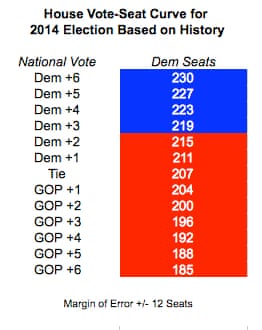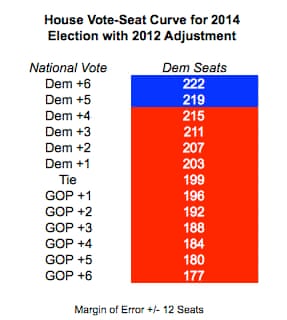Midterm elections are tough for the party in the White House. Since 1866 only thrice (1934, 1998, 2002) has the president's party not lost seats in a midterm. In all three of those elections, they gained fewer than 10 seats, which isn't even close to the 17 seats Democrats need to take the House today. The GOP will probably maintain control come 2014, but there still seems to be some misunderstanding about what type of national wave it would take for Democrats to take back the House.
The Democrats currently have a 5pt lead in the HuffPollster national House ballot aggregate. If it holds through 2014, the Democrats would be in good shape to win a majority in the House.
We can get a pretty good idea of how the national vote translates to seats utilizing a vote to seat curve. I prefer to use only the 21 elections since 1970, after civil rights reforms took effect. The curve shows how many seats each party won in the prior election and the result of the national vote. What's important is that the party who holds more seats is likely to hold an incumbent advantage. That is, an incumbent Democrat, for example, would tend to do better than a new Democrat running for the same seat. That's much of the reason that Democrats won the national House vote by a little over a point in 2012, but still failed to gain back the House.

This particular seat curve indicates that the Democrats need to win the national House vote by about 3pt to win control. That matches a similar percentage Republicans needed to win the house before the 2010 elections, and is very similar to a curve produced by Nate Silver before the 2012 elections. Given a similar national House vote as 2012, the Democrats should do better than the last election because of the incumbent advantage. It should be noted that the margin of error on a naive curve like this is at least +/-12 seats, because campaigns and candidates for individual seats matter quite a lot.
So why have some writers and analysts all but written off the Democrats, given this generic lead?
First, I'm not sure they quite comprehend how votes translates to seats. Many have pointed to gerrymandering as a problem for Democrats. That is partially true, but the vote seat curve was actually less accurate in 2010 than in 2012. Republicans outperformed by a dozen seats in 2010 – a record in the modern era. They did this because Democrats still held many seats in deep red territory, like Georgia, Mississippi and Tennessee, and the 2010 vote fell more closely along how districts voted in presidential elections. The bias in 2012 fell to nearly half its 2010 level, as most Democrats represented blue-leaning districts on the presidential level, and Republicans are situated in red districts.
Even if Democrats underperformed like they did in 2012 (not something I'm sure will happen), they would still be favored to win the house back with a 5pt national victory.

In the 2012 election, the tipping point race (ie the race that, along with other wins, would give a party the majority) was a 7pt Republican win. But in 2014 the Republican incumbency advantage will be weaker, as Democrats control more seats and a number of unique factors contribute to which race becomes a tipping point, including final terms, incumbents, and allocation of resources.
Second, the generic ballot is unlikely to hold. The party who controls the White House tends to lose ground as the midterm election approaches. Joe Bafumi, Bob Erikson and Chris Wlezien have done great work on midterm elections and found that, on average, a 5pt Democratic lead 300 days before the election can disappear completely in that time. Republicans, for instance gained significant momentum as 2010 progressed.
You find the same result in a model by Alan Abramowitz, that uses the national House polls in the September before the election and the margin in the prior presidential election. The model, like Bafumi et al, shows that the president's party performs worse than initial polls would imply. The model also takes into account the midterm presidential penalty, which shows that a larger win in the prior presidential election results in greater loss of seats in the midterm.
Neither Bafumi nor Abramowitz's model, though, forecast what analyst Charlie Cook suggests will happen, namely that Democrats won't win back the House if they win the national House vote by 5pt. Rather, Bafumi et al and Abramowitz's results merely predict that a 5pt lead now probably won't hold through the election. Usually, voters come back to the fundamentals – like a midterm loss for the president's party – say they will.
History, however, doesn't always hold. The 2002 election, for instance, started with George W Bush's Republicans holding a lead on the national ballot that expanded, if anything. It's possible that the Republicans' all-time record low standing may make this year different than other years before it.
I'd bet that the national environment for the 2014 midterm elections will turn against Democrats enough to keep them from winning the House. But if the environment does not become more favorable for Republicans, either, Democrats will have a solid chance to retake control.
